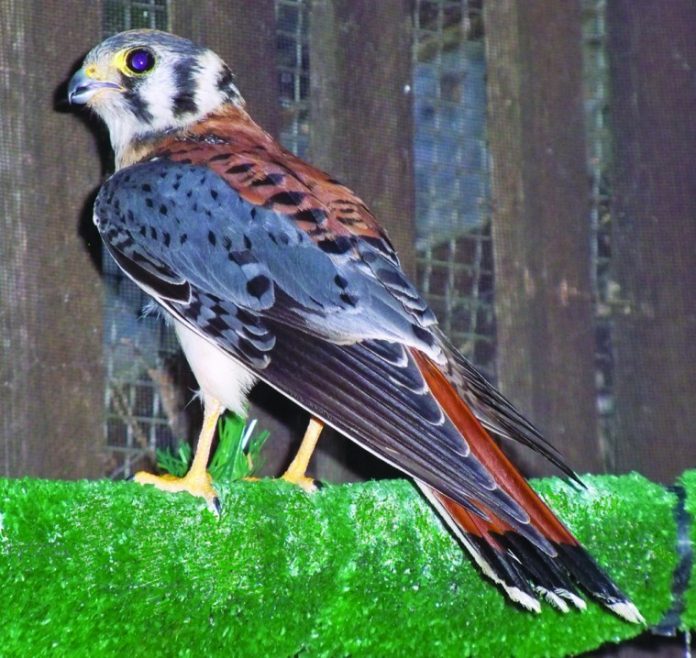Like an autumn leaf gliding on a breeze, a male kestrel gracefully floats over the bare field, waiting for a glimpse of an appetizing field mouse. His chestnut-colored back and tail and silvery-gray wings make him one of the most colorful of the raptors, a beautiful sight against a dreary October sky.
Unhappily for this particular male kestrel, he collided with a vehicle or other object while chasing after a meal in early September over a field near Calero Reservoir in south San Jose. He suffered a severe concussion and beak injury and was unable to stand or fly when rescued and brought to the Wildlife Education and Rehabilitation Center. Fortunately, for a bird-of-prey that relies on perfect physical condition in order to catch prey, the kestrel had not fractured his beak, wing or leg.
Unlike the speedy peregrine falcon, which can reach speeds of 200 mph while swooping down on prey, the kestrel hovers in the air and scans for the small rodents and insects that make up its typical meal. An equal opportunity bird-of-prey, it can also be found perching on fences and power lines, on the lookout for other potential food such as reptiles, frogs, bats and the occasional small bird, hence the kestrel’s common but erroneous nickname, “sparrow hawk.” In fact, its scientific name, Falco sparverius means a falcon “pertaining to a sparrow.” The kestrel has also been called a “grasshopper hawk” because of its fondness for that tasty insect and a “killy hawk” because of its distinctive killy-killy-killy call.
American kestrels are the smallest (9 inches long) falcon in North America and range across most of the north and south American continents. They dwell in a wide variety of habitats including fields, meadows, alpine zones, grasslands, marshes, prairies and deserts, favoring open areas with scant vegetation and trees. They are often found near areas of human activity including parks, towns, suburbs and cities. Although the kestrel is the most common falcon in the Americas, it is declining along the Atlantic and Pacific coasts, due to the continued removal of the standing dead trees these birds need for their nest sites and because of exposure to pesticides, which not only cause the failure of egg incubation but which also destroy so many of the insects on which the birds depend.
American kestrels are cavity-nesters, taking up residence in old woodpecker holes, natural tree hollows and rock crevices. They have adapted well to the human environment and build nests in building alcoves and other man-made structures.
Are you interested in helping to conserve the kestrel and also attracting this gorgeous and environmentally beneficial bird to your fields? Kestrels will readily occupy nest boxes placed high (15 to 30 feet above ground) on poles or on the side of a building. Directions for building and installing your own box can be found online. And if a kestrel doesn’t opt for the box, don’t be surprised if a screech owl finds it the ideal nesting spot, too. It’s a win-win situation.
After a month of rehabilitation to ensure that he was well-fed, healthy again and had perfect flight ability, WERC’s kestrel was released early in October, back to his original habitat. He flew immediately to the tip-top of a very high tree, swaying with a gentle breeze, and surveyed his old, familiar neighborhood, perhaps to seek out his mate for a happily-ever-after ending to this story.










